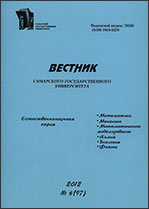|
This article is cited in 3 scientific papers (total in 3 papers)
Mechanics
Residual stresses in a thermoelastic cylinder resulting from layer-by-layer surfacing
S. A. Lycheva, Montaser Fekryb
a IPMech RAS, Moscow, Russian Federation
b Moscow Institute of Physics and Technology, Moscow, Russian Federation
(published under the terms of the Creative Commons Attribution 4.0 International License)
Abstract:
The article investigates the residual stresses arising in a thermoelastic cylinder as a result of layer-by-layer deposition of material on its lateral surface. Residual stresses are defined as the limiting values of internal stresses developing during the technological process. Internal stresses are caused by incompatible deformations that accumulate in the body as a result of joining parts with different temperatures. For the analysis of internal stresses, an analytical solution of the axisymmetric quasi-static problem of thermoelasticity for a layer-by-layer growing cylinder is constructed. It is shown that the distribution of residual stresses depends on the scenario of the surfacing process. In this case, the supply of additional heat to the growing body can significantly reduce the unevenness of the temperature fields and reduce the intensity of residual stresses. The most effective is uneven heating, which can be realized, for example, by the action of an alternating current with a tunable excitation frequency. This is illustrated by the calculations performed using the constructed analytical solution.
Keywords:
additive manufacturing, residual stresses, growing solids, thermoelasticity, analytical solutions.
Received: 13.03.2020
Revised: 27.03.2020
Accepted: 25.05.2020
Citation:
S. A. Lychev, Montaser Fekry, “Residual stresses in a thermoelastic cylinder resulting from layer-by-layer surfacing”, Vestnik SamU. Estestvenno-Nauchnaya Ser., 26:3 (2020), 63–90
Linking options:
https://www.mathnet.ru/eng/vsgu635 https://www.mathnet.ru/eng/vsgu/v26/i3/p63
|

| Statistics & downloads: |
| Abstract page: | 93 | | Full-text PDF : | 44 | | References: | 23 |
|




 Contact us:
Contact us: Terms of Use
Terms of Use
 Registration to the website
Registration to the website Logotypes
Logotypes








 Citation in format
Citation in format 
